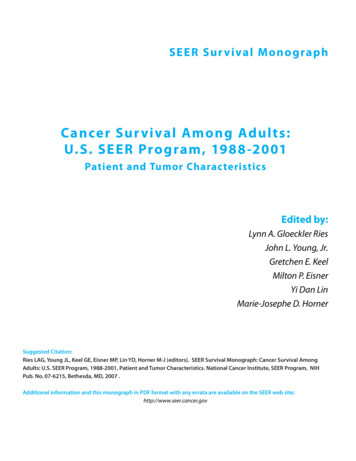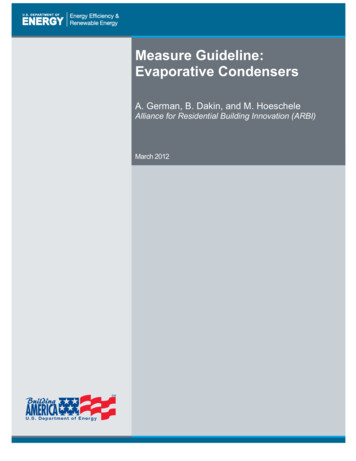
Transcription
SEER*Stat Technical WebinarJuly 14, 2011, 1pm-2pmAngela MariottoSteve ScoppaNadia HowladerHyunsoon Cho1
Outline New features in survival: Ederer II method to estimate expected survival inrelative survival Improved algorithm to specify the underlying cause ofdeath: the SEER cause-specific death classificationvariable New features of SEER*Stat Profiles tool in SEER*Stat version 7.0.4 to customizepreferences Sharing user-defined variables2
Brief Introduction to Survival Measures3
3 Measures of Cancer Survival Observed survival Probability of surviving allcauses of death Net Survival Probability of survivingcancer in the absence ofother causes of dearth Crude Probability ofdeath Probability of dying ofcancer and other causes4
Measures/Methods of Cancer SurvivalEstimation MethodNet cancer survival(Probability of survivingcancer in the absence ofother cause of death)Cause ofdeathExpectedsurvival(life tables)Crude probability of death(Probability of dying of cancer in thepresence of other causes of death)Cause-specificsurvivalCrude probability ofdeath using cause ofdeath informationRelative survivalCrude probability ofdeath usingexpected asures.html5
Ederer II method to estimate expectedsurvival in relative survival6
Measures/Methods of Cancer SurvivalEstimation MethodNet cancer survival(Probability of survivingcancer in the absence ofother cause of death)Cause ofdeathExpectedsurvival(life tables)Crude probability of death(Probability of dying of cancer in thepresence of other causes of death)Cause-specificsurvivalCrude probability ofdeath using cause ofdeath informationRelative survivalCrude probability ofdeath usingexpected survival7
Relative Survival Does not use cause of death information Standard method for reporting net cancersurvival from cancer registry data Measure of excess mortality experienced bycancer patients Uses expected survival to represent other-causesurvival for the patient group under study8
Relative Survival MethodRelative Survival Measure ofexcessmortalityexperienced bycancer patientsObserved survival Total mortalityexperienced bythe patientsExpectedSurvival Expected mortality ofa comparable groupfrom the generalpopulation Matched to thepatients with respectto the main factorsaffecting patientsurvival
Expected Survival Estimated from US life tables matched by age,sex, calendar time and race, to the cancerpatient cohort Assumes that life tables are representative ofpatients other-cause survival Methods differ with respect to how long matchedindividuals are considered to be at risk10
Methods to estimate expectedsurvival11
Methods to estimate expectedsurvival12
Ederer I vs. Ederer II Ederer I Unbiased estimate of expected survival proportion When applied to observed survival it usually overestimatesrelative survival Ederer II Controls for heterogeneous observed follow-up time itdepends on observed mortality Underestimates relative survival Closer to cause-specific survival Being adopted in international calculations of relativesurvival13
Relative survival estimates usingEderer I and Ederer II5-year relative survival estimates for selected cancer sites, SEER 17SEER Cancer Sites5-year relative estimates (%)95% confidenceintervalsEderer IEderer IIAbsolutedifference (I-II)All SitesProstate66.3599.2365.1699.331.19-0.10(66.27, 66.44) (65.08, 65.24)(99.05, 99.38) (99.14, 99.48)Breast89.1389.060.07(88.97, 89.29) (88.89, 89.22)Lung and Bronchus16.0515.470.58(15.88, 16.22) (15.31, 15.63)Colon and Rectum65.1964.250.95(64.92, 65.46) (63.98, 64.51)Melanoma of the Skin91.5391.150.38(91.21, 91.83) (90.84, 91.45)Urinary Bladder79.3778.151.22(78.93, 79.80) (77.72, 78.57)Corpus and Uterus, NOS82.6682.030.63(82.25, 83.06) (81.62, 82.43)Non-Hodgkin Lymphoma67.9266.251.67(67.52, 68.31) (65.86, .17, 97.68) (96.78, 97.29)(5.52, 6.02) (5.13, 5.60)14Ederer IEderer II
Relative survival for women diagnosedwith thyroid cancer all agesusing Ederer I , Ederer II and Hakulinen expected survival methods15
Comparison of relative survivalFemale patients diagnosed with thyroid cancer at all ages in the SEER-9 areas16
Conclusions Relative survival estimates, using any of the expected survivalmethods available, are very similar in most situations For cancer sites diagnosed at a wide range of ages, there might besmall differences at longer follow-up times Ederer II method is the new default for the new databases.Databases from previous versions still have Ederer I as default.Users can set default for their databases Recent developments in relative survival analysis suggest othermethods to estimate expected survival that might be less biased.Perme et al (2011)17
Expected Survival Options in SEER*StatEderer II is the default18
References SRP technical report Cho et. al Estimating relative survival for cancerpatients from the SEER Program using expectedrates based on Ederer I versus Ederer II /tech2011.01.pdf Perme et al. On Estimation in Relative Survival.Biometrics, 2011.19
Algorithm to specify an improvedunderlying cause of death: the SEERcause-specific death classificationvariable20
The SEER cause-specific deathclassification variableEstimation MethodNet cancer survival(Probability of survivingcancer in the absence ofother cause of death)Cause ofdeathExpectedsurvival(life tables)Crude probability of death(Probability of dying of cancer in thepresence of other causes of death)Cause-specificsurvivalCrude probability ofdeath using cause ofdeath informationRelative survivalCrude probability ofdeath usingexpected survival21
Why improve cause of death information? Population-based studies often report relativesurvival Cause of death (COD) information from deathcertificate Not always available to cancer registries Misclassification error Metastatic site of the primary cancer diagnosis may bereported as the underlying COD Difficult to assign CODs to a primary cancer diagnosis forpeople with multiple primaries22
Why improve cause of death information? Challenging to estimate expected/relativesurvival for subgroups of the population Lack of “appropriate” life-tables (e.g. ethnic minorities,risk factors, socioeconomic status, geographic area) Patients diagnosed with screen detected cancers Need to develop an algorithm to identify asingle, disease-specific, underlying COD23
SEER Cause-Specific DeathClassification Variable The algorithm takes into account COD in conjunction with Site of original cancer diagnosis Tumor sequence Sequence 00 (only one primary tumor) vs Sequence 01 (first of more than one tumor) Diseases related to the cancer of diagnosis (e.g., HIV/AIDS) COD was evaluated using respective InternationalClassification of Disease Codes (ICD) ICD-8 (1975-1978), ICD-9 (1979-1998), ICD-10 (1999 )24
Overview of the algorithm used to define theSEER COD Classification VariableDeath attributed to the specific cancer siteCause of deathgroupsSequence 00- Sequence 01 – first of more thanone & only oneone tumorprimaryCancer of the same siteYesYesCancer of the same bodysystemYesYesCancer of any other siteYesNo (in general)AIDS and cancer (B21)YesHIV/AIDS associated cancers*HIV alone (B20)HIV/AIDSassociatedcancers*HIV/AIDS associated cancers*Site –specific diseaseSelectiveSelective*HIV/AIDS associated cancers Oral Cavity and Pharynx, Cervix, Anus Cancer, Lymphomas,25and* Kaposi Sarcoma
COD codes (Sequence 26
COD codes (Sequence 27
Example: Cause-specific survival forpatients diagnosed with KaposisarcomaComparison of cause specific survival using Kaposi sarcoma deathvs. the SEER death variable28
Survival Probability5-year net survival for patients diagnosed withonly Kaposi sarcoma (KS)Year Since DiagnosisNote Five-year Kaposi sarcoma cancer survival by months since diagnosis, SEER-17, 2001-200729
PercentDistribution of causes of death for patientsdiagnosed with only Kaposi sarcoma*Other cause is treated as censored observation30
Example: 5-year net survival for mendiagnosed with local/regional prostatecancerOne example of the use of cause-specific survival when life tablesare not representative of the other causes survival of the populationunder study31
Survival ProbabilityCause-Specific & Relative Survival RateFor Early Stage Prostate CancerYear Since DiagnosisNote Five-year localized/regional prostate cancer survival by diagnosis time, SEER-17, 2001-2007Note Five-year early stage prostate cancer survival by months since diagnosis, SEER-17, 2001-200732
Survival ProbabilityCause-Specific & Relative Survival RateFor Early Stage Prostate CancerYear Since DiagnosisNote Five-year localized/regional prostate cancer survival by diagnosis time, SEER-17, 2001-2007Note Five-year early stage prostate cancer survival by months since diagnosis, SEER-17, 2001-200733
How to use the SEER cause-specificdeath classification variable inSEER*Stat34
SEER*Stat: Selection Tab35
36
37
38
39
40
41
For More Information http://seer.cancer.gov/causespecific/index.html Howlader, N., L. Ries, A. Mariotto, M. Reichman, J. Ruhl, and K.Cronin. “Improved Estimates of Cancer-Specific Survival Ratesfrom Population-Based Data”. Journal of National CancerInstitute, Vol102, Issue 20, October 2010.
Measures/Methods of Cancer Survival 5 Cause-specific. survival. Crude probability of . death using cause of . death information. Relative survival. Crude probability of . death using . expected survival. Net cancer survival (Probability of surviving cancer in the absence of other cause of death) Crude probability of death (Probability of dying .










